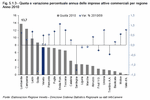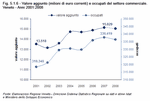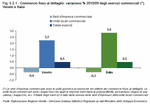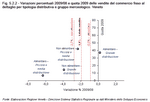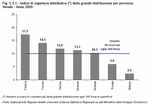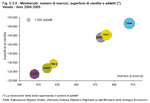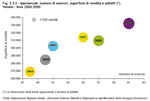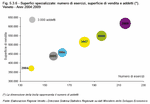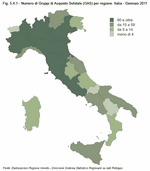-
Statistical departmentís site
Home page
Our publications
Chapter 5
The market in the hands of responsible consumers
Today's consumer is well-informed, demanding and above all, selective.
The compulsive consumerism that was rife some decades ago has now given way to a more aware and competent type of consumerism. This is how the consumer becomes a responsible one, putting into practice moral convictions through critical consumerism and being fully aware of the importance of social responsibility. This consumer plays a role of primary significance through conscious consumerism, which is driven by an understanding of the strong relationships between production systems, consumerism, ethics and the environment.
Data from SANA-GPF, the research and consultancy institute founded by Professor Giampaolo Fabris (Note 1), show that citizens are ever more attentive towards these matters: 50.6% of Italians declared in 2010 that they were more careful about the environmental impact of their consumer habits and their daily lifestyle than in the previous year. The most popular green products in 2010 were energy-saving lightbulbs, rechargeable batteries and recycled paper.
Many initiatives, both individual and informal, have been undertaken in Italy in recent years to reduce the environmental impact of private consumption.
One such initiative, which has been in place since 1st January 2011, is the ban on producing and selling carrier bags which do not conform to biodegradability requirements, as set out in the current European technical standards (Note 2). Italian environmental group Legambiente estimates that the prohibition of non-biodegradable plastic carrier bags, which pollute and are dangerous for the environment, will reduce CO2 levels released into the atmosphere every year by hundreds of thousands of tonnes.
The compulsive consumerism that was rife some decades ago has now given way to a more aware and competent type of consumerism. This is how the consumer becomes a responsible one, putting into practice moral convictions through critical consumerism and being fully aware of the importance of social responsibility. This consumer plays a role of primary significance through conscious consumerism, which is driven by an understanding of the strong relationships between production systems, consumerism, ethics and the environment.
Data from SANA-GPF, the research and consultancy institute founded by Professor Giampaolo Fabris (Note 1), show that citizens are ever more attentive towards these matters: 50.6% of Italians declared in 2010 that they were more careful about the environmental impact of their consumer habits and their daily lifestyle than in the previous year. The most popular green products in 2010 were energy-saving lightbulbs, rechargeable batteries and recycled paper.
Many initiatives, both individual and informal, have been undertaken in Italy in recent years to reduce the environmental impact of private consumption.
One such initiative, which has been in place since 1st January 2011, is the ban on producing and selling carrier bags which do not conform to biodegradability requirements, as set out in the current European technical standards (Note 2). Italian environmental group Legambiente estimates that the prohibition of non-biodegradable plastic carrier bags, which pollute and are dangerous for the environment, will reduce CO2 levels released into the atmosphere every year by hundreds of thousands of tonnes.
The opinion of Italian businesses
(Note 3) The confidence of retail businesses, which hit a low point at the end of 2008 and the beginning of 2009, was seen to pick itself up during the remaining months of 2009 to reach levels which were then maintained, with some fluctuations, throughout 2010 and into the first months of 2011.Traditional retail has remained generally more optimistic in the last year than large-scale distribution, which is more critical towards the situation of stocks and suppliers' prices and in its expectations on prices of sales. Traditional trade, on the other hand, is worried about sales trends and expectations on the volume of orders, areas where its optimism, which has risen elsewhere, has not yet recovered the ground lost during the crisis of recent years. The first few months of 2011 were a little up-and-down: confidence dropped in January but started to pick itself up again immediately in February when sales expectations improved. (Figure 5.1.1)
Sales in Italy in 2010
The index of retail sales showed that market activity in the retail sector picked up slightly in 2010: the year closed with a 0.2% overall increase in sales compared to the previous year; this is the result of a 0.3% increase in non-food products and an identical decrease in sales of foodstuffs. The 0.2% increase in total sales comes from a 0.7% increase in large-scale distribution sales and a 0.4% reduction for small-scale businesses, where the food sector suffered in particular (-1.4% compared to 2009). In terms of large-scale distribution, specialised businesses and non-specialised businesses dealing mainly in non-foodstuffs increased the most (both +2% compared to 2009). (Figure 5.1.2) In terms of non-food products, the market groups with the highest annual increase in sales were photography-optics and films (+2.2%), electrical appliances, radio, tv and recording devices (+1.9%), storage devices and musical instruments (+1.7%); the most consistent drops were in I.T., telecommunications and telephone equipment (-1.1%).
Commercial enterprises in Veneto
Trade is Veneto's leading production sector in its tertiary industry: in 2010 active trade enterprises made up 43.1% of service enterprises and 23% of all production businesses in Veneto. On a national scale, Veneto trade businesses constitute 7.4% of the Italian trade sector, putting Veneto in fifth place after Lombardia, Campania, Lazio and Sicilia for share of trade businesses.Trade in Veneto closed 2010 with a positive variation in the number of active enterprises: +0.5% on the previous year. This sector showed more stability therefore than the Veneto economy as a whole, which saw a slight reduction (-0.2%).
The trade sector grew the most in 2010 in the provinces of Vicenza, Verona, Padova and Rovigo with increases of between 0.5% and 1.6% per annum in the number of active enterprises. In the provinces of Venezia and Belluno the numbers decreased. In 2010 Padova was still the province with the highest share of trade enterprises, with 22.1% of the regional total. (Figure 5.1.3) and (Figure 5.1.4)
The quarterly trends for trade in Veneto highlight a clear recovery in retail and repair of personal objects and household goods, a sector which increased continually from the second quarter of 2009 to the end of 2010, with one slight exception in the first quarter in 2010 when it decreased marginally. Overall, retail increased by almost one percentage point in 2010 compared to the previous year.
Over the last two years, both wholesale trade and trade in cars have had to deal with alternating quarterly periods of expansion and contraction, although they have managed to maintain stability compared to the previous year, with a positive annual variation of 0.6%. (Figure 5.1.5)
The economic impact of the trade sector
Value added to base prices in the trade sector in Veneto in 2008 (Note 4) was estimated by the Ministry for Economic Development at over 15 billion euro, a slight decrease, given in current values, on the figure for 2007. It represents over 11% of overall value added produced in Veneto.The total number of workers in the trade sector in Veneto is estimated to be over 336,000, more than 14% of total workers. Of these, 52.7% are employed workers. This figure decreased by 0.4% compared to 2007, with the number of self-employed shrinking the most (-2.9%). (Figure 5.1.6)
Value added in the Veneto trade sector for 2008 made up 9.6% of the national aggregate, however the share of personnel is lower, at 9.2% of the national total. In a comparison between regions, Veneto stands out as one of the regions with higher worker productivity, together with Lombardia and Lazio. In Veneto the ratio of value added per employee was last estimated at 44,674 euro per employee; this figure is significantly higher than the Italian average of 42,709 euro per employee.
Commercial enterprises
Let us now take a look at one component of the distribution system: retail.At the end of 2010 there were 51,923 establishments stating retail as their main activity.
There was a certain amount of development in commercial enterprises in the course of 2010: parent companies decreased slightly in Veneto compared to the previous year, but local units which are not head offices of the commercial enterprises increased by more than two percentage points compared to the end of 2009, resulting in an overall growth of 0.5%.
The data therefore confirm that the trend is for commercial enterprises to multi-locate. This springs from the tendency of new enterprises to take on the form of "distribution chains"; as a matter of fact, the new establishments tend more and more to consist in local units.
The distribution of enterprises by form shows that sole traders are more prevalent, 50.1% of the total in Veneto, followed by partnerships at 27.3%, and corporations at 20.9%.
Trade follows the same general trend as Veneto enterprises overall, as corporations continue to increase, even though at a very slow pace, at the expense of sole traders above all.
An analysis by goods specialised-in shows that at the end of 2010 13.4% of enterprises in Veneto were not specialised. If we take a look instead at the specialised enterprises, the main goods in the retail sector are clothing and footwear (21% of total commercial enterprises), foodstuffs, beverages and tobacco (15.8%), some household goods, such as furniture and electrical appliances (14.8%), some cultural and recreational items, such as books, games, sports or music equipment (9.1%). (Figure 5.2.1)
Retail sales in Veneto
The unfavourable economic situation of the last two years has certainly affected the retail sector. In 2009 volumes of sales in Veneto decreased by 1.9% compared to the previous year, due mainly to the reduction in sales of non-foodstuffs, down 2.7 percentage points in the same period. Sales of foodstuffs, which had been completely stable up until the previous year, decreased by 0.9% in 2009, with big differences between the types of distribution: large-scale distribution of foodstuffs was fairly stable (+0.2%), whereas small-scale distribution of foodstuffs dropped considerably (-6.4%). The first semester of 2010 witnessed a clear recovery in retail of non-foodstuffs, as sales increased in small- and medium-scale distribution by 1.5% compared to the same semester in 2009, and by 1.7% in large-scale distribution. As far as the foodstuffs sector is concerned, sales continued to decrease in the first semester of 2010, especially through small and medium-scale distribution (-3% compared to the same semester of the previous year). (Figure 5.2.2) The favourable trend for large-scale distribution in Veneto can also be seen through the fact that the market share held by this type of distribution had increased regularly in recent years, until it accounted for 51.1% of retail sales in 2009. This constituted an increase of more than 3 percentage points compared to 2005.
The volume of retail sales in Veneto equals 9.3% of the national total, putting Veneto in third place in the regional ranking for sales, after Lombardia and Lazio (18.5% and 9.9% of the national total respectively). If we focus exclusively on large-scale distribution, Veneto moves into second place after Lombardia for its share of the national total, with volumes of sales making up 11.3% of Italian large-scale distribution sales. If we compare regional sales with the demographic size of the regions concerned, then we can see that Valle d'Aosta, Emilia Romagna and Veneto are the regions with the highest values of sales per capita, each one with figures of over 5,000 euro per year, per citizen.
The evolution of the large-scale distribution sales network in Veneto
At this point in the proceedings, we must take the time to focus on one particular section of the retail network: large-scale organised distribution (LOD). Overall, large-scale distribution structures remained stable in 2009; in the last year there was a very slight increase in the number of establishments, +0.27% compared to 2008. The regional trend results from situations which sometimes differ greatly from province to province: Venezia and Vicenza provided fertile ground for large-scale distribution in the last year, with increases in numbers of establishments of +9.9% and +5.1% per annum respectively.The situations in Verona and Padova were the least favourable with -5.1% and -4.4% at the end of the year. The advantages provided by large-scale distribution have once again managed to keep these competitive channels of distribution in the hands of the consumers.
There are an average of 10 large-scale organised distribution establishments per 100 km2, with many differences to be found within the region: the province of Padova has the most large-scale distribution retail outlets, with 17 per 100 km2, followed by the provinces of Vicenza, Treviso and Verona with more than 11 establishments per 100 km2. Belluno and Rovigo, which have 2.4 and 5.9 establishments per 100 km2 respectively, are positioned a lot lower than the regional average.
Veneto and some other regions in the North and Centre of Italy, such as Trentino, Umbria, Valle d'Aosta, Friuli and Marche, have high figures for availability of large-scale organised distribution retail outlets compared to demographic size of the area in question: in Veneto there are 37.7 large-scale organised distribution establishments per 100,000 inhabitants. The national average is 30.7 establishments per 100,000 inhabitants. (Table 5.3.1) and (Figure 5.3.1)
Department stores, supermarkets and hypermarkets
Department stores operate in the non-foodstuffs sector, have a sales surface area of at least 400 m2 and contain at least 5 separate departments, each of which sells articles belonging to different product groups, mainly consumer goods.Supermarkets, on the other hand, operate in the foodstuffs sector, they function on a "self-service" principle with payment to be made on the way out, have a sales surface area of between 400 m2 and 2,500 m2 and have a large range of fast moving consumer goods, mainly pre-packaged, and some non-foodstuff items for domestic use.
Hypermarkets are retail outlets with a sales surface area of over 2,500 m2 and are split into sections for foodstuffs and non-foodstuffs.
In 2009 Veneto had a total of 1,227 establishments comprising department stores, supermarkets and hypermarkets, the same number as in 2008. These establishments took up an average of 1,251 m2 each and had 27,000 employees. The provinces with the highest number of establishments were Padova, Verona, Vicenza and Treviso, as each one had at least 200 retail outlets of one of these three types.
If we look closely at the evolution of the types of distribution under consideration we can see that hypermarkets are settling in Veneto and growing steadily: in 2009 the number of establishments grew by 7% and their surface area by 7.2%. The number of employees, however, increased by less than 1% per year.
This type of distribution establishment has increased significantly over the last 5 years (+27.8% in establishments, +23.4% in surface area). This growth has been driven by the fact that products here are better value for money than in other types of distribution establishments, especially since the financial crisis has caused so much strain and worry.
Supermarkets are fairly well-established as retail outlets: from 2004 to 2007 supermarkets grew by an average of 4.2% per year, their relative surface areas by 5.3% per year and the number of employees by 2.9% per year. Since 2008 the trend for this type of establishment has remained fairly constant, with more moderate growth. At the end of 2009 there were 1.5% more supermarkets in Veneto than the previous year and the relative variation in terms of surface area of sales equalled 1.8% for the same period. Employment followed a similar trend, with an increase of 1.3% for number of employees for the same period.
Department stores, however, after some years of market stability, hit a sharp downturn in 2008 and 2009: at the end of 2009 the number of department stores had decreased by as much as 27.3% on the previous year, with a corresponding 8.1% reduction in sales surface area and 16% reduction in sales staff.
Minimarkets
This type of establishment operates in the food sector and has a sales surface area of between 200 m2 and 399 m2. It has the same characteristics as a supermarket, but it differs by range of products and size as supermarkets have a much bigger sales surface area. It is also very different from a specialised food shop, which has a narrower range of produce. These medium-small sized establishments are mainly to be found in town centres.There were 406 minimarkets in Veneto on 31 December 2009, covering a total sales surface area of almost 124,000 m2 and employing 2,315 people. These establishments are mainly to be found in the provinces of Treviso, Padova and Verona, with 100, 81 and 78 minimarkets respectively, whereas Rovigo and Belluno have fewer than 25 each. Up until 2006 this type of retail establishment found itself in a period of great expansion, whereas the last three years have seen great reductions in terms of number and size of establishments. The trend in the number of employees has been more up-and-down. In 2009 the number of minimarkets in Veneto decreased by 3.1%, with a 2.4% decrease in surface area compared to the previous year. In the same period, however, the number of employees in this type of commercial activity increased by 1.7%. The trend regarding minimarkets in Veneto is not in line with Italy as a whole where, thanks especially to the regions in the Centre and South of the country, there was continual growth in all of the areas considered: +2.6% in establishments, +4.8% in employees, +2.4% in sales surface area.
Specialist stores
This type of retail outlet operates in the non-foodstuffs sector and deals either exclusively or mainly with a specific range of products on a sales surface area of at least 1,500 m2.There were 215 specialist stores in Veneto in 2009, occupying almost 617,000 m2 in surface area. In the same year, there were 5,425 employees in this sector, making up 15.7% of all employees involved in large-scale distribution.
A close look at types of goods shows that in 2009 the "Furniture, Furnishings, Upholstery" sector dominated in Veneto, making up 27.9% of establishments. This was followed by "Textiles, Clothing, Fur" (23.7%), "Hardware, DIY, Gardening" (14.4%) and "Electrical Appliances, Electronics, I.T." (14%). If we break it down to the provincial level, we can see that the provinces of Verona, Treviso, Padova and Venezia have the highest number of specialist stores with 55, 50, 43 and 33 retail outlets respectively, employing a total of almost 5,000 sales staff.
Of the types looked at, it is the large specialist stores that have proved to be the most dynamic. Since the beginning of the Noughties they have expanded in all areas: number of establishments, sales surface area and number of employees all continue to grow strongly, so much so that the amount of people employed in large specialist stores almost doubled in five years (from 2,926 people in 2004 to 5,425 in 2009).
In 2009 there were an extra 9.7% retail outlets of this type, leading to a 12.5% increase in sales surface area and an 11.6% increase in the number of employees.
The strong points of this type of retail outlet are the wide range of goods available of a certain product type, qualified personnel to provide pre and post sales assistance and competitive prices. These were the factors that enabled specialist stores to evolve so rapidly, leading to an inevitable decrease in trade for more traditional shops and for department stores. (Figure 5.3.2), (Figure 5.3.3), (Figure 5.3.4), (Figure 5.3.5) and (Figure 5.3.6)
Green attitudes within large-scale organised distribution
As has already been touched upon, our 21st century society is starting to pay careful attention to rationalising consumption. Industries are investing in rethinking packaging, aiming towards a more responsible attitude to it by using recyclable materials, or materials which can be disposed of more easily. The common aim is to reduce the production of waste caused by purchases, and the large-scale distribution sector is working towards this on a daily basis, also by attempting to make consumers more aware of such issues as sustainability and, where possible, trying to change their models of consumption. It is within this context that machines distributing liquids on tap are becoming more popular, both for foodstuffs and non, e.g. for personal hygiene and domestic products.Nowadays, the consumer is encouraged to move away from impulse buys towards more careful and well-thought-out decision-making. Responsible behaviour can achieve important results not only with regards waste reduction but also in terms of saving money for families themselves: a survey carried out by Italy's Giornale dei Servizi Ambientali (Journal of Environmental Services) has shown that consumers buy products on tap first of all out of curiosity, but that half of them then continue to buy products in this fashion because they can actually save money by doing so.
In this paragraph we will give an overview of some forms of responsible and sustainable consumerism, meaning those forms of consumerism in which choices are made to move towards more virtuous production types such as organic produce, Fairtrade, as well as small local producers. Here we shall move away therefore from gestures of objection, for example boycotting or working against dependence on large-scale distribution and traditional trade in general. We will take a further look instead at some new models of consumption, whose aims include quality and sustainability and which often make use of short distribution channels. A short distribution channel is a type of distribution where there is a direct transaction between the producer and the consumer, in this way making it possible to cut out all the intermediate steps between a product's manufacture and its end use, thus enabling the consumer to regain control and power of choice over the product and the producer. Short distribution channels also lead to greener consumption, cutting down completely on packaging and transport of goods with positive consequences for the environmental impact of trade.
Consumption of alternative food products is still considered a niche market: the conviction that two domains need to be taken into account for the good of the consumer, the individual and the collective, is not yet widespread. The consumer is becoming more aware of the satisfaction that comes not only from consuming good quality produce, but also from care paid by the producer towards the environment, care taken over raw materials, workers' rights, and products firmly rooted in the local area.
The groups buy everyday products wholesale and redistribute them amongst their members, in this way the volume of purchase is big enough to optimise on transport costs and to get hold of goods which are more difficult to find. The members of these groups are consumers who have decided to apply the concept of solidarity to their day-to-day purchasing habits.
A study published in Italian financial paper Sole 24 Ore (Note 5) has shown that, for a basket containing 15 products, shopping through an Ethical Purchasing Group, where all the products are organic and of excellent quality, can cost almost twice as much as the top prices offered by large-scale distribution. However, it can also cost as much as 20% less for the same quantity of organic products sold through large-scale distribution. (Figure 5.4.1) and (Table 5.4.1)
In January 2011 Veneto had 68 Ethical Purchasing Groups forming part of the national network. These groups are mainly to be found in the provinces of Vicenza and Verona, followed by Padova, Venezia and Treviso.
It should be made clear that not all the groups are officially registered or structured: these data do not include those non-official groups which are active but do not form part of the national network. At the beginning of the year Veneto was fourth in Italy's regional rankings for the number of Ethical Purchasing Groups in the national network, preceded by Lombardia, Toscana and Piemonte. These types of groups are still slow getting off the ground in some of the southern regions and also in Friuli Venezia Giulia and Trentino Alto Adige.
In the new farmers markets therefore goods are sold directly to the consumer, having travelled zero food miles; the short distribution channel, which cuts down on the steps from field to fork, means prices can be kept lower than in the supermarkets.
For a more in-depth, quantitative look at farmers markets in Veneto, please see Chapter 13.
Raw milk distributors are also expanding greatly; they benefit from a short distribution channel as they are stocked directly by the farmers themselves.
Here costs are significantly reduced by cutting out the bottling and transport stages. In recent years in Veneto, regulations have been adopted to encourage the consumption of agricultural products with zero food miles, involving also local restaurants and catering businesses. The main aim is to promote the sale and consumption of these products, thus ensuring price transparency for the consumer and guaranteeing the origins of produce.
The retail distribution network which promotes Fairtrade products, i.e. the Fairtrade shops, extends over most of Europe: in 2005 the largest number of Fairtrade shops were to be found in Germany, Italy, Holland and Switzerland with more than 300 shops each. These were followed by Belgium, France, Austria and the United Kingdom with at least 100 Fairtrade shops each. In 2005 there were around 600 Fairtrade shops in Italy, mainly located in the North West and the North East, which contained 38% and 22.5% of total shops respectively.
Some Fairtrade products, usually only foodstuffs, are also sold through the large-scale distribution network; in 2005 there were more than 3,000 supermarkets in Germany, France, Italy, Norway, Holland and Great Britain which also stocked Fairtrade products.
Unfortunately, these 2005 figures do not enable us to estimate the current spread of Fairtrade products as this sector has expanded enormously in the last decade. More than 55% of Fairtrade shops came into being after 2000 (Barbetta, 2006).
Last year the Regional list of Fairtrade organisations (Regional Law LR 22 January 2010, no. 6, art. 4 and 9) was set up in Veneto. The list contained 20 Fairtrade organisations managing Fairtrade shops in Veneto in December 2010. The provinces in which these organisations are most present are Verona, Vicenza and Venezia, each one with at least 4 Fairtrade organisations registered on the above-mentioned list. The region has also decided to intervene to lend its support to Fairtrade organisations (Regional Government Decree DGR no.1507 of 08.06.2010) in the following ways:
This is one of the sectors seen as a priority in European strategy, which views sustainable development as a pillar of competitiveness; the European Commission officially defines Green Public Procurement as: "a process whereby public authorities seek to procure goods, services and works with a reduced environmental impact throughout their life cycle when compared to goods, services and works with the same primary function that would otherwise be procured".
In Europe, public authorities are amongst the most important consumers when it comes to spending power; if we take into account computers, buildings, not to mention transport and tenders, it is clear what an enormous impact their purchases have on the environment. Introducing green criteria into the purchasing procedures enables public authorities, both central and local, not only to minimise the environmental impact of their investments, but also to influence a large share of the market towards a greener economy, rewarding companies which invest in the environmental aspects of their products and services.
Italy's Ministry of the Environment and of the Protection of Land and Sea, following the indications of the European Commission, has adhered to the National plan of action on "Green Procurement", through which it outlines strategies and methodologies that work towards environmental sustainability in public spending. The action plan has three main objectives: to use resources sparingly and efficiently, particularly energy resources, in order to cut down on CO2; to cut down on the use of dangerous substances; and to reduce the amount of waste produced.
Consumption of alternative food products is still considered a niche market: the conviction that two domains need to be taken into account for the good of the consumer, the individual and the collective, is not yet widespread. The consumer is becoming more aware of the satisfaction that comes not only from consuming good quality produce, but also from care paid by the producer towards the environment, care taken over raw materials, workers' rights, and products firmly rooted in the local area.
Collective purchasing to boost excellent local producers: Ethical Purchasing Groups
Ethical Purchasing Groups sprang up to encourage critical consumerism through purchasing from small local producers who respect both people and the environment. In this way, there is no need for intermediaries and the members benefit from the advantages of being part of a group in terms of organisation, saving money and time and not having to seek out suitable producers.The groups buy everyday products wholesale and redistribute them amongst their members, in this way the volume of purchase is big enough to optimise on transport costs and to get hold of goods which are more difficult to find. The members of these groups are consumers who have decided to apply the concept of solidarity to their day-to-day purchasing habits.
A study published in Italian financial paper Sole 24 Ore (Note 5) has shown that, for a basket containing 15 products, shopping through an Ethical Purchasing Group, where all the products are organic and of excellent quality, can cost almost twice as much as the top prices offered by large-scale distribution. However, it can also cost as much as 20% less for the same quantity of organic products sold through large-scale distribution. (Figure 5.4.1) and (Table 5.4.1)
In January 2011 Veneto had 68 Ethical Purchasing Groups forming part of the national network. These groups are mainly to be found in the provinces of Vicenza and Verona, followed by Padova, Venezia and Treviso.
It should be made clear that not all the groups are officially registered or structured: these data do not include those non-official groups which are active but do not form part of the national network. At the beginning of the year Veneto was fourth in Italy's regional rankings for the number of Ethical Purchasing Groups in the national network, preceded by Lombardia, Toscana and Piemonte. These types of groups are still slow getting off the ground in some of the southern regions and also in Friuli Venezia Giulia and Trentino Alto Adige.
Farmers markets and 0 food miles: producers and consumers create a shared route
For some years now farmers markets have also been coming into town centres: producers are now able to sell their produce directly to the consumer. Farmers markets are for local agricultural holdings whose produce must be fresh or processed within the holding itself.In the new farmers markets therefore goods are sold directly to the consumer, having travelled zero food miles; the short distribution channel, which cuts down on the steps from field to fork, means prices can be kept lower than in the supermarkets.
For a more in-depth, quantitative look at farmers markets in Veneto, please see Chapter 13.
Raw milk distributors are also expanding greatly; they benefit from a short distribution channel as they are stocked directly by the farmers themselves.
Here costs are significantly reduced by cutting out the bottling and transport stages. In recent years in Veneto, regulations have been adopted to encourage the consumption of agricultural products with zero food miles, involving also local restaurants and catering businesses. The main aim is to promote the sale and consumption of these products, thus ensuring price transparency for the consumer and guaranteeing the origins of produce.
A new development model: Fairtrade
In the last few decades, Fairtrade has sprung to the forefront of international attention. Fairtrade refers to a certain type of international trade led by non-profit organisations which manage the exports of goods from developing countries through a distribution network of specialised retail establishments: Fairtrade shops. The products dealt with are mainly agricultural produce or small handicrafts. This type of trade aims to guarantee producers and workers in developing countries receive fair and decent wages and treatment in order to move away from the widespread practices of exploitation and maximisation of profits. The producers are committed to guaranteeing the environmental sustainability of their production processes and to respecting certain minimum requirements regarding their employees' working conditions. Importers of Fairtrade produce in wealthy countries are committed to guaranteeing producers the minimum orders and prices they have agreed upon, as well as multi-year contracts, which ensure a minimum of continuity for production, and consultations on the produce and production techniques.The retail distribution network which promotes Fairtrade products, i.e. the Fairtrade shops, extends over most of Europe: in 2005 the largest number of Fairtrade shops were to be found in Germany, Italy, Holland and Switzerland with more than 300 shops each. These were followed by Belgium, France, Austria and the United Kingdom with at least 100 Fairtrade shops each. In 2005 there were around 600 Fairtrade shops in Italy, mainly located in the North West and the North East, which contained 38% and 22.5% of total shops respectively.
Some Fairtrade products, usually only foodstuffs, are also sold through the large-scale distribution network; in 2005 there were more than 3,000 supermarkets in Germany, France, Italy, Norway, Holland and Great Britain which also stocked Fairtrade products.
Unfortunately, these 2005 figures do not enable us to estimate the current spread of Fairtrade products as this sector has expanded enormously in the last decade. More than 55% of Fairtrade shops came into being after 2000 (Barbetta, 2006).
Last year the Regional list of Fairtrade organisations (Regional Law LR 22 January 2010, no. 6, art. 4 and 9) was set up in Veneto. The list contained 20 Fairtrade organisations managing Fairtrade shops in Veneto in December 2010. The provinces in which these organisations are most present are Verona, Vicenza and Venezia, each one with at least 4 Fairtrade organisations registered on the above-mentioned list. The region has also decided to intervene to lend its support to Fairtrade organisations (Regional Government Decree DGR no.1507 of 08.06.2010) in the following ways:
- initiatives to raise awareness of Fairtrade and to provide consumers with information about the consequences of their choices in terms of consumption;
- initiatives providing information and raising awareness about Fairtrade products which are certified and guaranteed by bodies affiliated to Fairtrade Labelling Organizations International (FLO);
- workshops in schools aimed at teaching children about the issues surrounding the implications of consumer choices;
- Fairtrade days aimed at increasing knowledge and awareness.
Green Public Procurement: green purchases made by public authorities
Green Public Procurement (GPP) is one of the main tools public authorities have at their disposal to rationalise public spending and to reduce the environmental impact of their purchases, by managing their resources and waste more responsibly.This is one of the sectors seen as a priority in European strategy, which views sustainable development as a pillar of competitiveness; the European Commission officially defines Green Public Procurement as: "a process whereby public authorities seek to procure goods, services and works with a reduced environmental impact throughout their life cycle when compared to goods, services and works with the same primary function that would otherwise be procured".
In Europe, public authorities are amongst the most important consumers when it comes to spending power; if we take into account computers, buildings, not to mention transport and tenders, it is clear what an enormous impact their purchases have on the environment. Introducing green criteria into the purchasing procedures enables public authorities, both central and local, not only to minimise the environmental impact of their investments, but also to influence a large share of the market towards a greener economy, rewarding companies which invest in the environmental aspects of their products and services.
Italy's Ministry of the Environment and of the Protection of Land and Sea, following the indications of the European Commission, has adhered to the National plan of action on "Green Procurement", through which it outlines strategies and methodologies that work towards environmental sustainability in public spending. The action plan has three main objectives: to use resources sparingly and efficiently, particularly energy resources, in order to cut down on CO2; to cut down on the use of dangerous substances; and to reduce the amount of waste produced.



